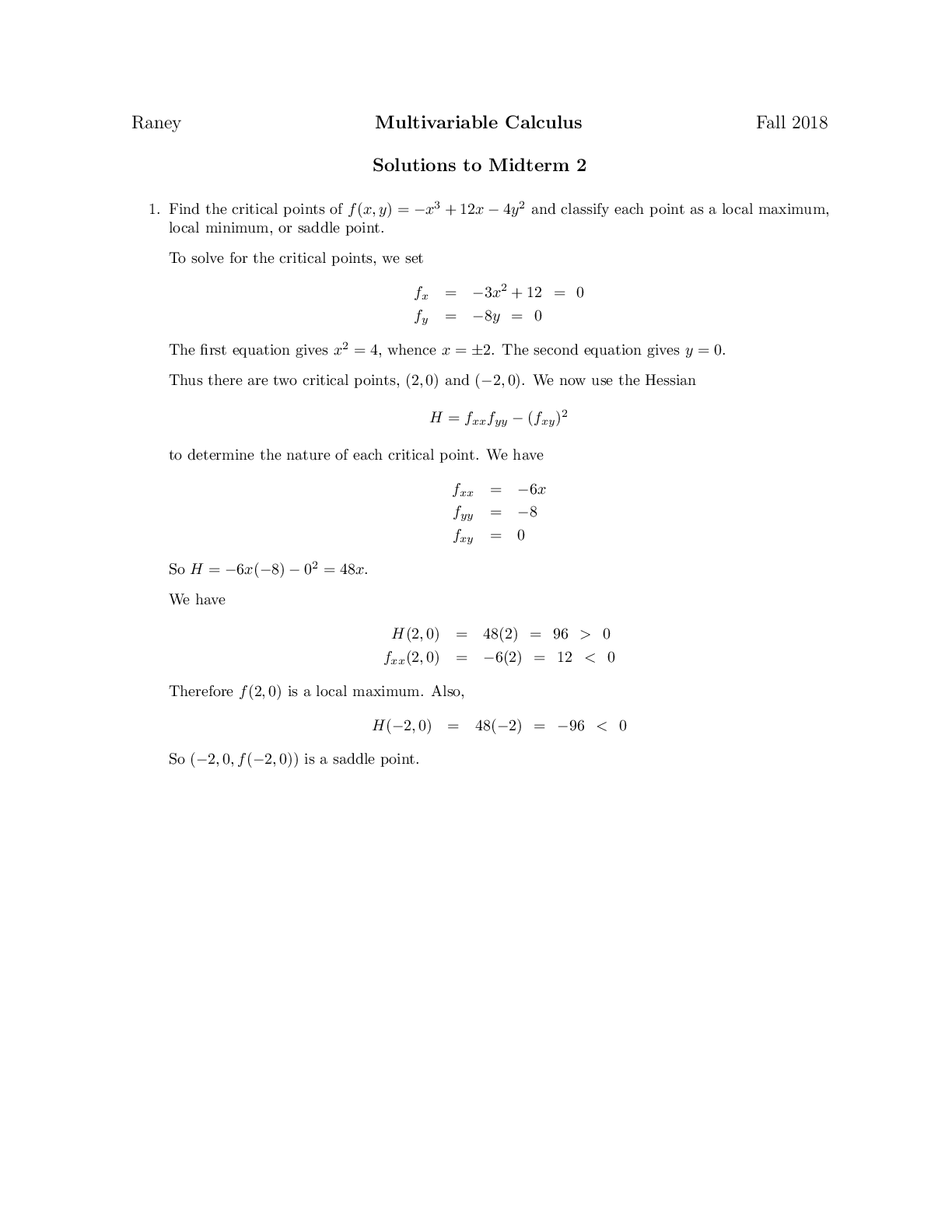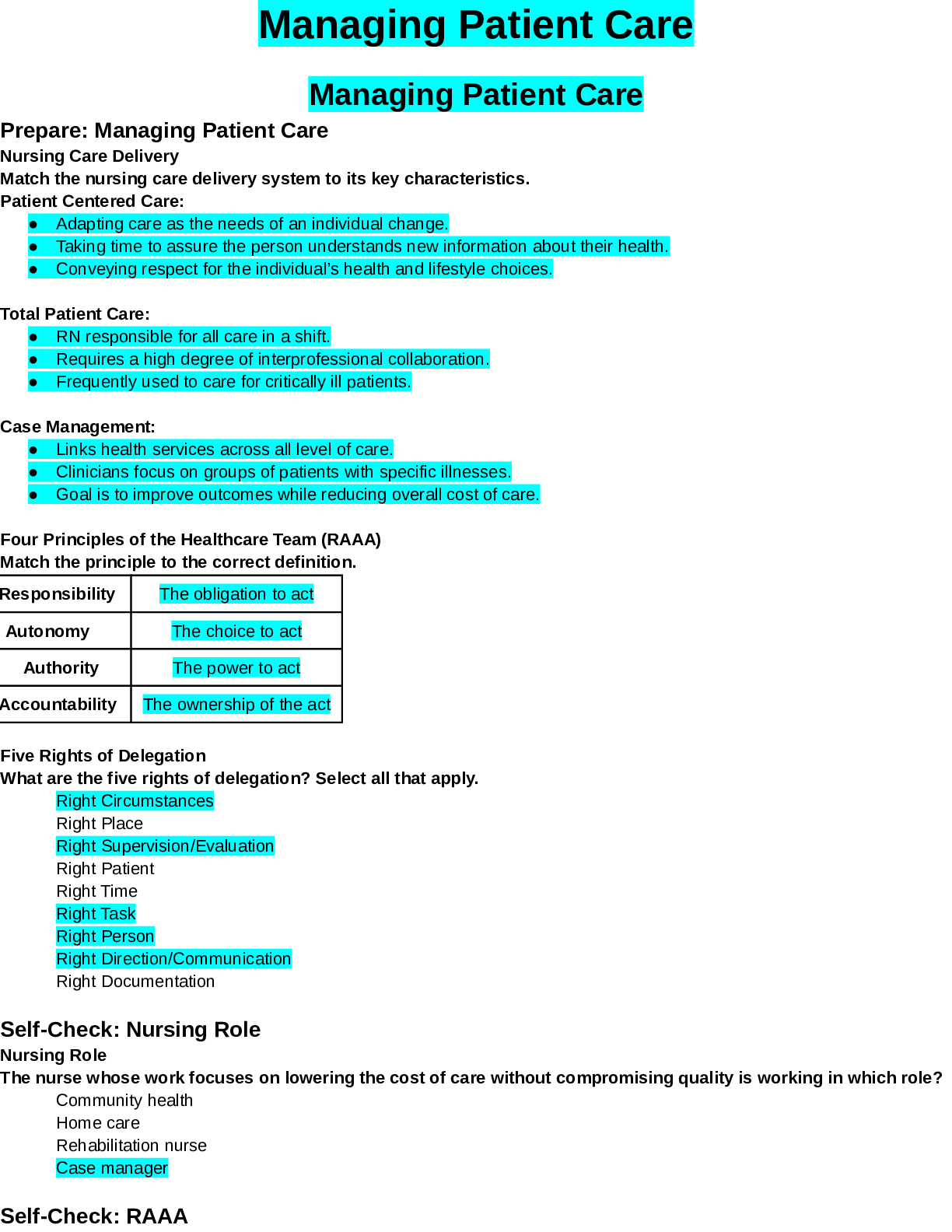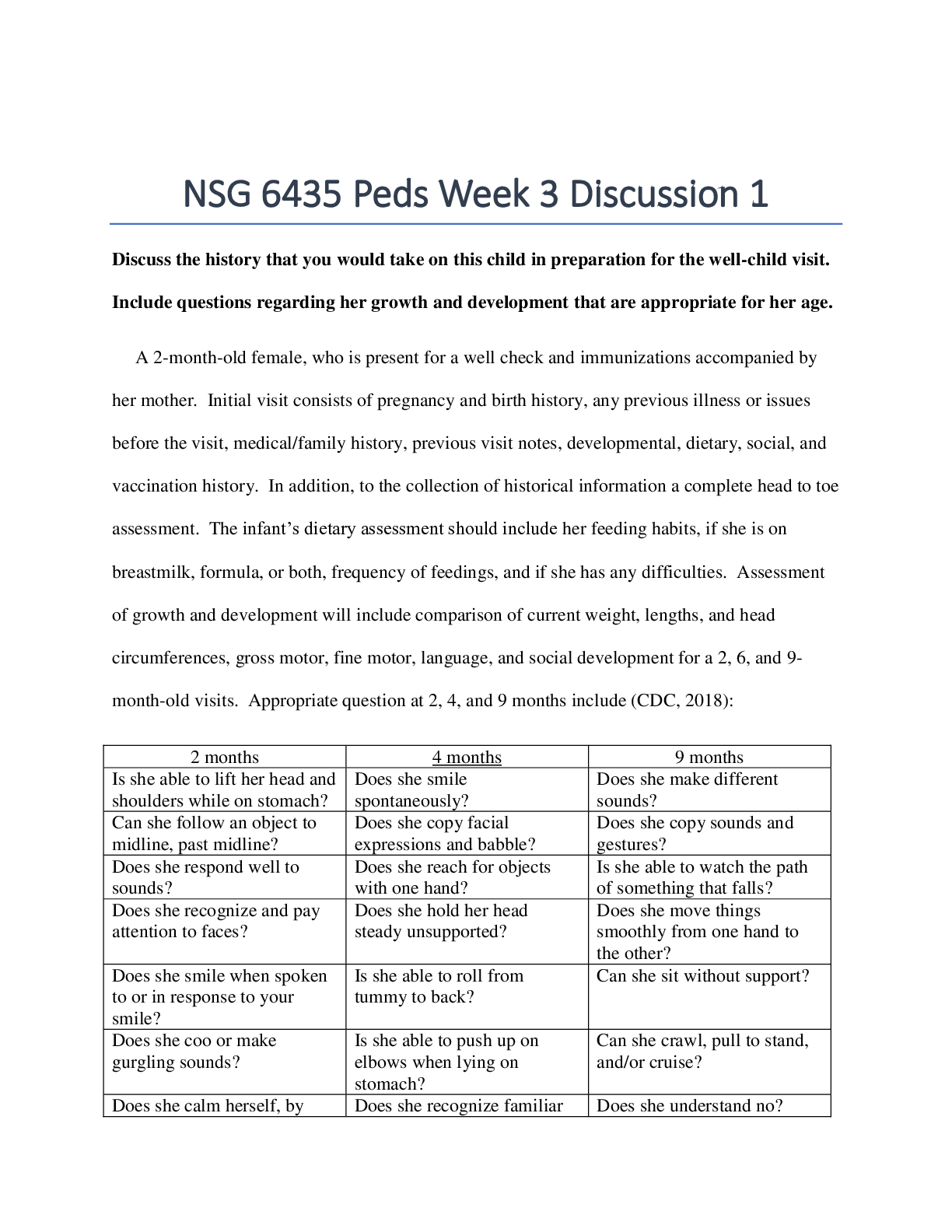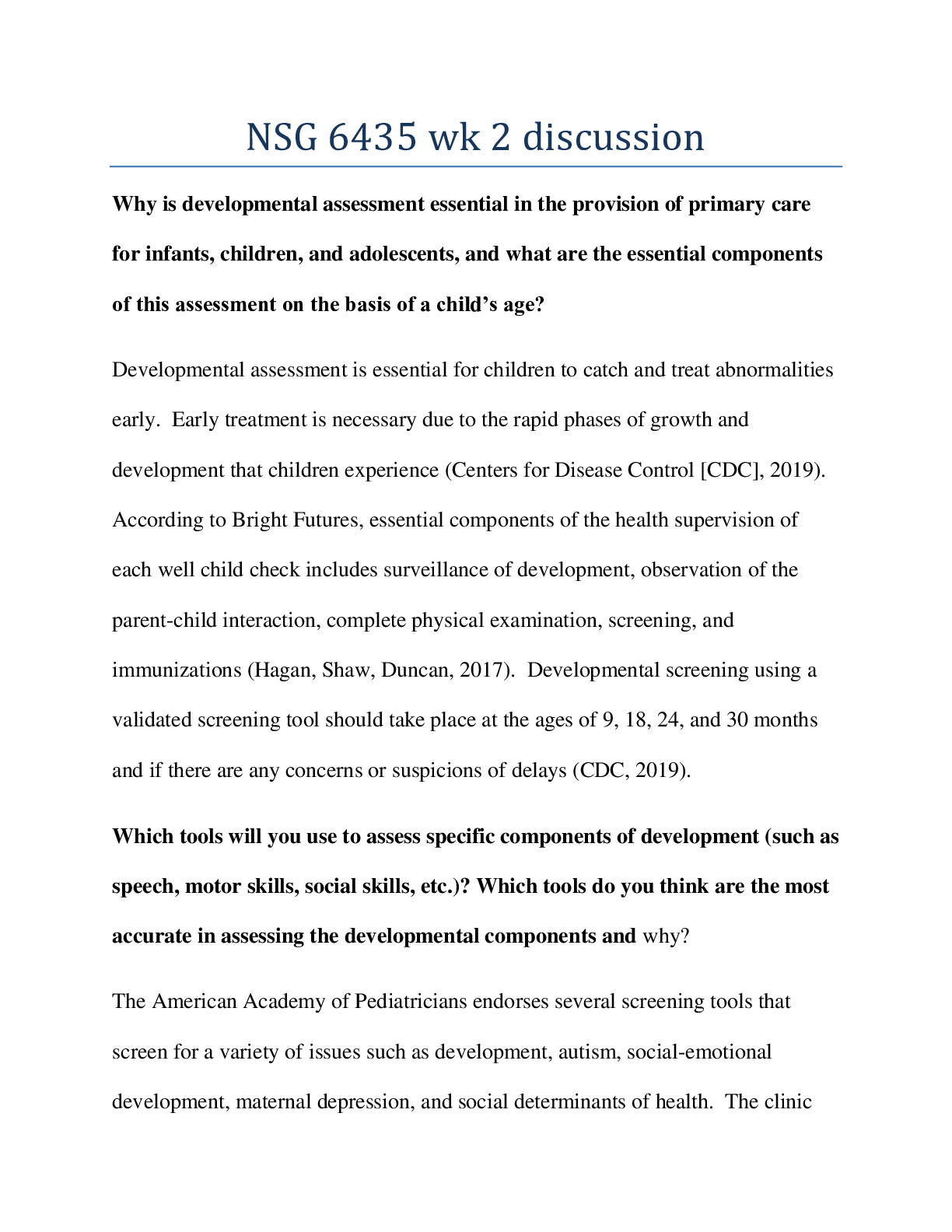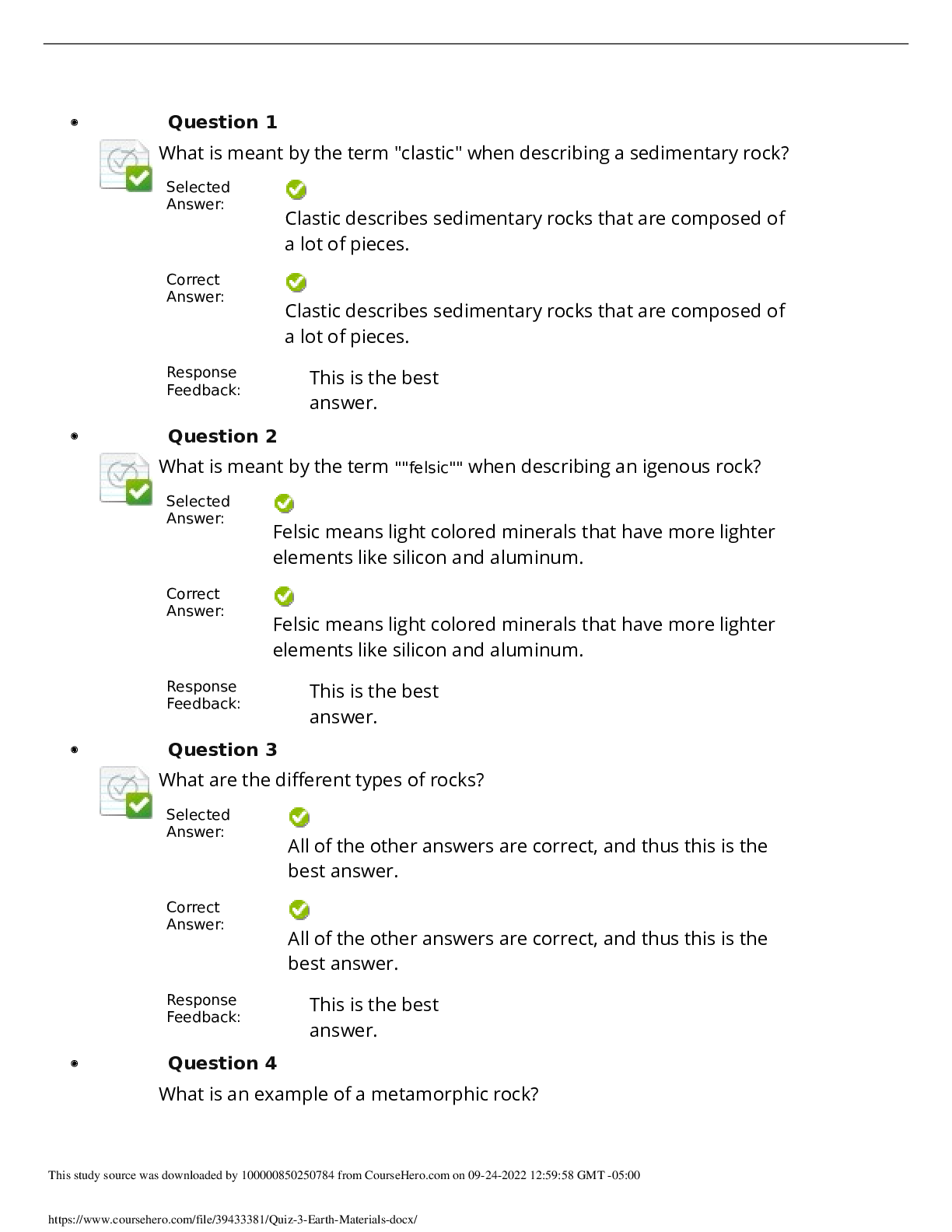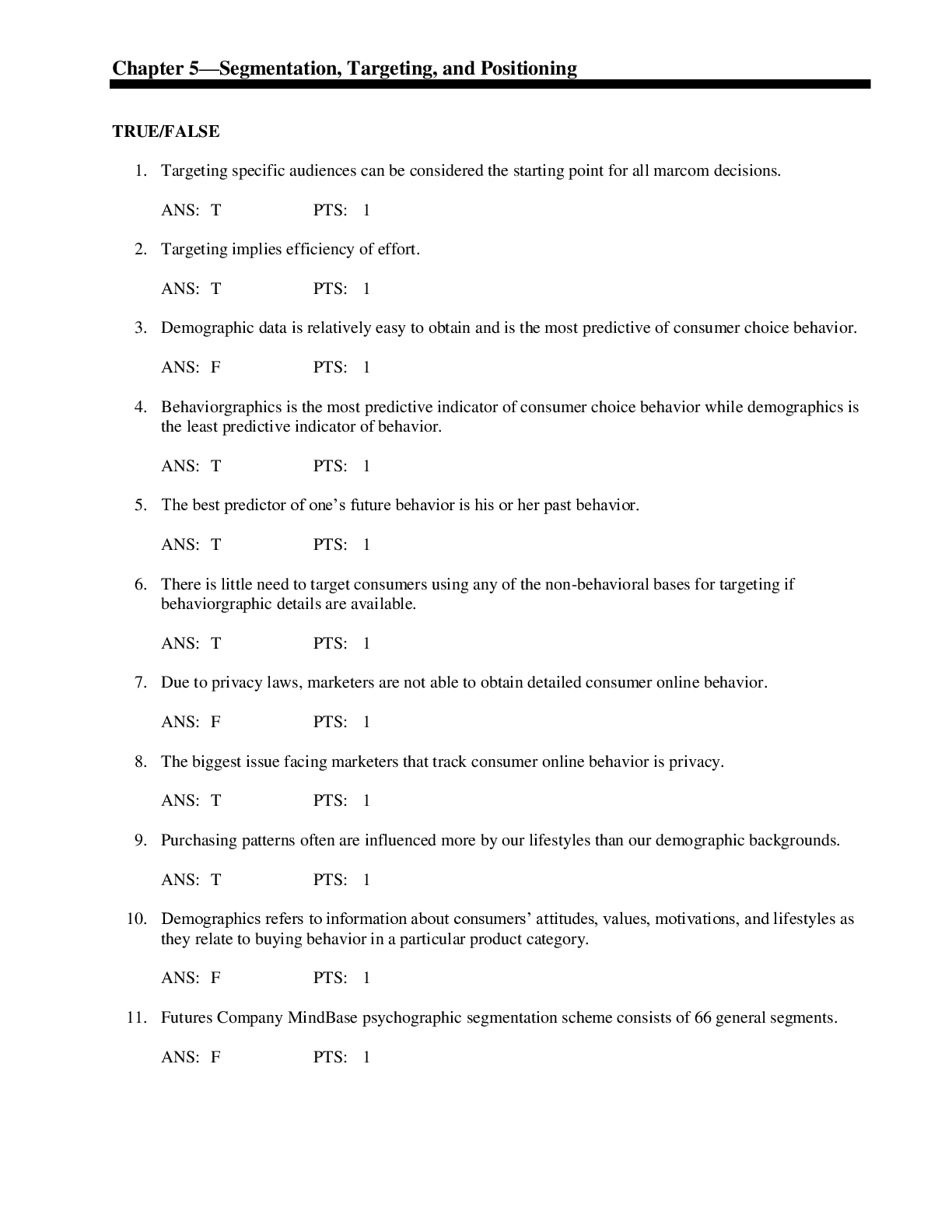*NURSING > QUESTIONS & ANSWERS > PrepU – Neonate Review Questions and Answers with Explanation (All)
PrepU – Neonate Review Questions and Answers with Explanation
Document Content and Description Below
PrepU – Neonate Review Questions and Answers with Explanation Question 1 A client who used heroin during her pregnancy gives birth to a neonate. When assessing the neonate, the nurse expects ... to find: Question 2 Sick and preterm neonates who experience continuity of nursing care directly benefit from: Question 3 After the birth of her first neonate, a mother asks the nurse about the reddened areas at the nape of the neonate's neck. How should the nurse respond? Question 4 When assessing a postterm neonate, what is considered a normal finding? Question 5 A nurse is administering vitamin K to a neonate following birth. The medication comes in a concentration of 2 mg/ml, and the ordered dose is 0.5 mg to be given subcutaneously. How many milliliters would the nurse administer? Record your answer using two decimal places. Question 1 A nurse is performing a neurologic assessment on a neonate. Which sign is considered a normal finding in a neonate? Question 2 After completing discharge instructions for a primiparous client who is bottle-feeding her term neonate, the nurse determines that the mother understands the instructions when the mother says that she should contact the pediatrician if the neonate exhibits which sign or symptom? Question 3 A neonate born at 40 weeks' gestation admitted to the nursery is found to be hypoglycemic. At 4 hours of age, the neonate appears pale and his pulse oximeter is reading 75% on room air. The nurse should: Question 4 The nurse is caring for a newborn of a primiparous woman with insulin-dependent diabetes. When the mother visits the neonate at 1 hour after birth, the nurse explains to the mother that the neonate is being closely monitored for symptoms of hypoglycemia because of which reason? Question 5 The nurse observes a darkish blue pigment on the buttocks and back of a neonate of African descent. Which action is most appropriate? Question 1 A nurse assesses a 1-day-old neonate. Which finding indicates respiratory distress? Question 2 Which factor plays the smallest role in thermoregulation in the preterm neonate? Question 3 During a home visit to a primiparous client 1 week postpartum who is bottle-feeding her neonate, the client tells the nurse that her mother has suggested that she feed the neonate cereal so he will sleep through the night. What would be the nurse's best response? Question 4 When developing the plan of care for a neonate who was diagnosed with an anorectal malformation and who subsequently underwent surgery, what intervention would be most helpful in facilitating parent–infant bonding? Question 5 When the nurse accidentally bumps the bassinet, the neonate throws out its arms, hands opened, and begins to cry. The nurse interprets this reaction as indicative of which reflex? Question 1 When teaching parents of a neonate the proper position for the neonate's sleep, a nurse stresses the importance of placing the neonate on his back to reduce the risk of: Question 2 A nurse is assisting with a circumcision. After the physician has started the procedure, the nurse reviews the neonate's medical record and notices that an informed consent form hasn't been signed. What should the nurse do? Question 3 While caring for a just born female term neonate, the nurse observes that the neonate’s clitoris is enlarged and there is some fusion of the posterior labia majora. The nurse should notify the health care provider because these findings are associated with which problem? Question 4 On the first postpartum day, a neonate diagnosed with an ABO incompatibility has a bilirubin level of 10 mg/dL (170 µmol/L). After teaching the parents about this condition, which statement by the parents about the neonate indicates the need for additional teaching? Question 5 A mother who is breastfeeding and has known food sensitivities is asking the nurse what foods she should avoid in her diet. Which foods should the nurse advise the client to avoid? Select all that apply. Question 1 A client is concerned that her 2-day-old, breast-feeding neonate isn't getting enough to eat. The nurse should teach the client that breast-feeding is effective if: Question 2 Sick and preterm neonates who experience continuity of nursing care directly benefit from: Question 3 Which action is the best precaution against transmission of infection? Question 4 A neonate born 18 hours ago with myelomeningocele over the lumbosacral region is scheduled for corrective surgery. Preoperatively, what is the most important nursing goal? Question 5 A 15-year-old primipara who gave birth to a term neonate vaginally tells the nurse, “My mother started feeding me rice cereal when I was only 2 weeks old.” What would be the most appropriate response to the client? Question 1 A nurse assigns to a neonate an Apgar score of 8 at 5 minutes. The nurse understands that this score indicates: Question 2 A nursery nurse just received the shift report. Which neonate should the nurse assess first? Question 3 A neonate is experiencing respiratory distress and is using a neonatal oxygen mask. An unlicensed assistive personnel has positioned the oxygen mask as shown. The nurse is assessing the neonate and determines that the mask: Question 4 Commercial formulas contain 20 calories per 30 mL. A 1-day-old infant was fed 45 mL at 0200, 0530, 0800, 1100, 1400, 1630, 2000, and 2230. What is the total amount of calories the infant received today? Record your answer using a whole number. Question 5 A neonate has been placed on cardiac and apnea monitoring in the neonatal nursery. The nurse notes that the apnea alarm repeatedly triggers. Place the following actions in the order in which they would be completed by the nurse. All options must be used. Question 1 A nursery nurse performs an assessment on a 1-day-old neonate. During the assessment, the nurse notes discharge from both of the neonate's eyes. The nurse should take which step to help determine whether the neonate has ophthalmia neonatorum? Question 2 A person calls the neonatal intensive care unit stating that his son is receiving care there. He tells the nurse that he and the mother "aren't together," and requests information about his son's condition. The nurse should: Question 3 Question 4 The nurse is preparing to administer erythromycin ophthalmic ointment to a neonate soon after birth. The nurse should explain to the parents that this medication, in addition to preventing blindness caused by gonococcal organisms, also prevents neonatal Question 5 The nurse has completed discharge teaching with new parents who will be bottle-feeding their normal term newborn. Which statement by the parents reflects the need for more teaching? Question 1 A male neonate underwent circumcision. What nursing intervention is part of the initial care of a circumcised neonate? Question 2 While caring for a male neonate diagnosed with gastroschisis, the nurse observes that the parents seem hesitant to touch the neonate because of his appearance. The nurse determines that the parents are most likely experiencing which stage of grief? Question 3 A family has taken home their newborn and later received a call from the child’s health care provider (HCP) that the phenylketonuria (PKU) levels for their newborn daughter are abnormally high. Additional testing confirmed the diagnosis of phenylketonuria. The parents refuse to believe the results as no one else in their family has the disease. The nurse explains that the disease: Question 4 The nurse makes a home visit to a 3-day-old full-term neonate who weighed 3,912 g (8 lb, 10 oz) at birth. Today the neonate, who is being bottle-fed, weighs 3,572 g (7 lb, 14 oz). Which instruction should the nurse give to the mother? Question 5 While assessing a male neonate whose mother desires him to be circumcised, the nurse observes that the neonate’s urinary meatus appears to be located on the ventral surface of the penis. The primary health care provider is notified because the nurse suspects which of the following? Question 1 After explaining to a primiparous client about the causes of her neonate's cranial molding, which statement by the mother indicates the need for further instruction? Question 2 After teaching the multiparous mother about hemolytic disease of the newborn and Rh sensitization, the nurse determines that the client understands why she was not sensitized during her other pregnancy when she makes which statement? Question 3 The parents of a neonate with hypospadias and chordee wish to have him circumcised. Which explanation should the nurse incorporate into the discussion with the parents concerning the recommendation to delay circumcision? Question 4 A multigravida client has given birth to a large-for-gestational age infant with Apgar scores of 8 and 9. The priority nursing assessment for this infant is for: Question 5 An infant is born with facial abnormalities, growth retardation, and vision abnormalities. These abnormalities are likely caused by maternal: Question 1 A client is concerned that her 2-day-old, breast-feeding neonate isn't getting enough to eat. The nurse should teach the client that breast-feeding is effective if: Question 2 Parents who bring a 3-week-old neonate to the hospital report that he's been "throwing up after every feeding." A nurse notes projectile vomiting while assessing the neonate. X-rays confirm: Question 3 After teaching the mother about the neonate’s positive Babinski’s reflex, the nurse determines that the mother understands the instructions when she says that a positive Babinski’s reflex indicates which condition? Question 4 After teaching the client about bottle-feeding, which client statement indicates the need for additional teaching? Question 5 A preterm neonate admitted to the neonatal intensive care unit at about 30 weeks’ gestation is placed in an oxygenated isolette. The neonate’s mother tells the nurse that she was planning to breastfeed the neonate. Which instructions about breastfeeding would be most appropriate? Question 1 While assessing a 2-hour-old neonate, a nurse observes that the neonate has acrocyanosis. Which nursing action should the nurse perform at this time? Question 2 A nursery nurse performs an assessment on a 1-day-old neonate. During the assessment, the nurse notes discharge from both of the neonate's eyes. The nurse should take which step to help determine whether the neonate has ophthalmia neonatorum? Question 3 A nurse is preparing a neonate for circumcision. Which behavior is the best example of nursing advocacy? Question 4 While assessing a male neonate whose mother desires him to be circumcised, the nurse observes that the neonate’s urinary meatus appears to be located on the ventral surface of the penis. The health care provider (HCP) is notified because the nurse suspects which complication? Question 5 Which action would be most appropriate after assessing a neonate’s cry as infrequent, weak, and very high pitched? Question 1 A neonate is admitted to the nursery following a long and difficult labor. Admission vital signs are temperature 96.5° F (35.8° C), heart rate 168 beats/minute, and respiratory rate 64 breaths/minute. After placing the neonate under the radiant heater, the nurse should take which action? Question 2 After circumcision with a Plastibell, the nurse should instruct the neonate's mother to cleanse the circumcision site with which agent? Question 3 What should the nurse expect to find in a premature female neonate born at 30 weeks’ gestation who is small for gestational age? Question 4 The nurse carefully documents the premature neonate’s response to oxygen therapy, delivering only as much oxygen as is necessary to prevent the development of which complication? Question 5 The nurse is performing an admission assessment on a neonate and finds the femoral pulses to be weaker than the brachial and radial pulses. The next nursing action should be to: Question 1 A client received magnesuim sulfate during labor. Which condition should the nurse anticipate as a potenial problem in the neonate? Question 2 A nurse caring for a preterm neonate knows that positioning can benefit high-risk neonates. Which position is appropriate for a preterm neonate? Question 3 The health care provider (HCP) prescribes ampicillin 100 mg/kg/dose for a newly admitted neonate. The neonate weighs 1,350 g. How many milligrams should the nurse administer? Record your answer using a whole number. Question 4 An infant is born with facial abnormalities, growth retardation, and vision abnormalities. These abnormalities are likely caused by maternal: Question 5 A viable neonate was delivered 10 minutes ago and is in stable condition under a radiant warmer. To prevent infant heat loss by convection, the nurse should: Question 1 A nurse is reviewing a client's maternal prenatal record and notes that the mother used narcotics during her pregnancy. A primary nursing intervention when caring for a drug-exposed neonate is to: Question 2 The client asks the nurse, “How can I tell whether my baby is spitting up or vomiting?” The nurse explains that, in contrast to regurgitated material, vomited material is characterized by: Question 3 When developing a teaching plan for the parents of a neonate who is to receive phototherapy, the nurse should give the parents which information? Select all that apply. Question 4 One hour after receiving nalbuphine for pain during labor, a primigravida gives birth to a full-term neonate with symptoms of respiratory depression. The nurse anticipates that the neonate will require the administration of which drug? Question 5 A neonate is experiencing respiratory distress and is using a neonatal oxygen mask. An unlicensed assistive personnel has positioned the oxygen mask as shown. The nurse is assessing the neonate and determines that the mask: Question 1 When caring for the neonate of a mother with gestational diabetes, which finding is most indicative of a hypoglycemic episode? Question 2 While caring for a male neonate diagnosed with gastroschisis, the nurse observes that the parents seem hesitant to touch the neonate because of his appearance. The nurse determines that the parents are most likely experiencing which stage of grief? Question 3 A primigravid client in early labor tells the nurse that she was exposed to rubella at about 14 weeks' gestation. After birth, the nurse should assess the neonate for which complication? Question 4 While caring for a mother and her 1-day-old neonate born vaginally at 30 weeks' gestation, the nurse explains about the neonate's need for gavage feeding at this time instead of the mother's plan for bottle feeding. What should the nurse include as the rationale for this feeding plan? Question 5 A mother who is breastfeeding and has known food sensitivities is asking the nurse what foods she should avoid in her diet. Which foods should the nurse advise the client to avoid? Select all that apply. [Show More]
Last updated: 2 years ago
Preview 1 out of 35 pages

Buy this document to get the full access instantly
Instant Download Access after purchase
Buy NowInstant download
We Accept:

Reviews( 0 )
$9.00
Can't find what you want? Try our AI powered Search
Document information
Connected school, study & course
About the document
Uploaded On
Aug 04, 2020
Number of pages
35
Written in
Additional information
This document has been written for:
Uploaded
Aug 04, 2020
Downloads
0
Views
183

